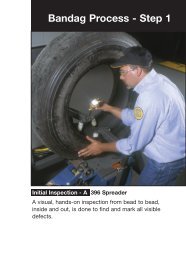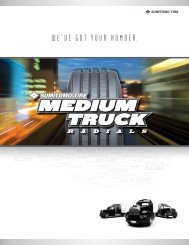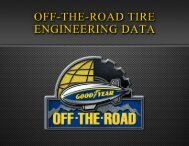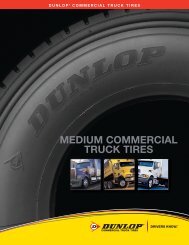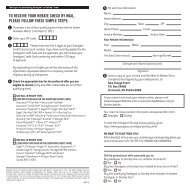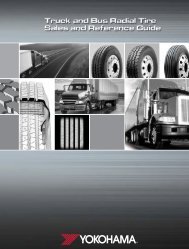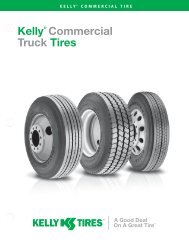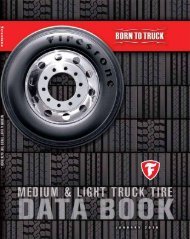Bridgestone Medium and Light Truck Tire Data Book - Sullivan Tire ...
Bridgestone Medium and Light Truck Tire Data Book - Sullivan Tire ...
Bridgestone Medium and Light Truck Tire Data Book - Sullivan Tire ...
You also want an ePaper? Increase the reach of your titles
YUMPU automatically turns print PDFs into web optimized ePapers that Google loves.
Effective January 2010<br />
General Technical Information<br />
M. Wheel Alignment<br />
Proper wheel alignment is essential for optimum tire<br />
life <strong>and</strong> vehicle h<strong>and</strong>ling characteristics. Alignment<br />
settings should be checked with the truck loaded.<br />
Alignment adjustments can be made on an unloaded<br />
truck; however, modifications in the vehicle<br />
manufacturer’s alignment recommendations may be<br />
required for proper “loaded” settings.<br />
Front Axle Recommendations<br />
• Toe-in: set as close to zero as vehicle<br />
manufacturer’s recommendations allow in loaded<br />
condition. Do not set beyond zero, as a toe-out<br />
condition will develop.<br />
• Caster: set to the maximum positive setting<br />
which the vehicle manufacturer’s recommendations<br />
will allow.<br />
• Camber: set as close to zero degrees as the<br />
vehicle manufacturer’s recommendations allow<br />
in loaded condition.<br />
Drive Axle Recommendations<br />
Misalignment of the drive axles may also cause rapid<br />
or irregular wear on the front axle as well as the<br />
drive axle due to constant steering correction. Drive<br />
axle alignment should be corrected before front axle<br />
settings are made.<br />
Drive axles should be aligned in the following manner:<br />
1. Position drive axles perpendicular to the<br />
chassis centerline.<br />
2. For t<strong>and</strong>em drives, the drive axles should be<br />
positioned parallel to one another.<br />
If they are not parallel, the condition is referred to as<br />
“t<strong>and</strong>em scrub.” Our recommendation is the distance<br />
between the axle centers is set so the distance on the<br />
right is equal to or greater than the distance on the left<br />
by up to 1/8" (.125").<br />
The distance on the axle centers on the right should<br />
never be shorter than the distance on the left. The wear<br />
pattern that will result from this situation is inside left<br />
front/outside right front shoulder wear.<br />
C L <strong>Tire</strong><br />
Toe-in (Positive) AB<br />
Vertical C L<br />
Toe-In<br />
Caster<br />
King Pin C L<br />
Camber Angle in Degrees<br />
Center Line of <strong>Tire</strong><br />
Vertical Line<br />
Camber<br />
Caster Angle<br />
Front View<br />
<strong>Medium</strong> <strong>Truck</strong> <strong>Light</strong> <strong>Truck</strong> General Technical Load/Inflation Technical Bulletins<br />
75



